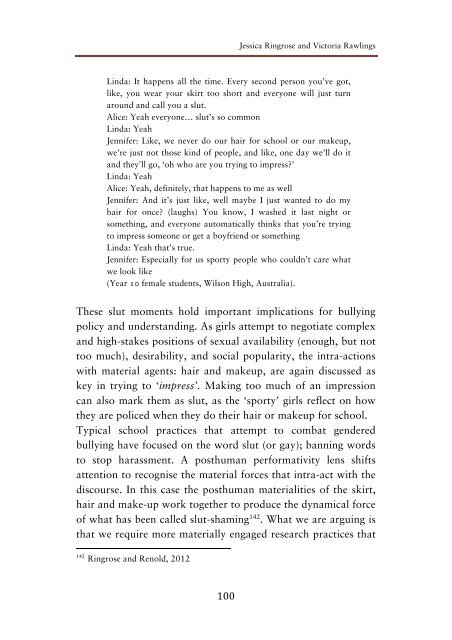Create successful ePaper yourself
Turn your PDF publications into a flip-book with our unique Google optimized e-Paper software.
Jessica Ringrose and Victoria Rawlings<br />
Linda: It happens all the time. Every second person you’ve got,<br />
like, you wear your skirt too short and everyone will just turn<br />
around and call you a slut.<br />
Alice: Yeah everyone… slut’s so common<br />
Linda: Yeah<br />
Jennifer: Like, we never do our hair for school or our makeup,<br />
we’re just not those kind of people, and like, one day we’ll do it<br />
and they’ll go, ‘oh who are you trying to impress?’<br />
Linda: Yeah<br />
Alice: Yeah, definitely, that happens to me as well<br />
Jennifer: And it’s just like, well maybe I just wanted to do my<br />
hair for once? (laughs) You know, I washed it last night or<br />
something, and everyone automatically thinks that you’re trying<br />
to impress someone or get a boyfriend or something<br />
Linda: Yeah that’s true.<br />
Jennifer: Especially for us sporty people who couldn’t care what<br />
we look like<br />
(Year 10 female students, Wilson High, Australia).<br />
These slut moments hold important implications for bullying<br />
policy and understanding. As girls attempt to negotiate complex<br />
and high-stakes positions of sexual availability (enough, but not<br />
too much), desirability, and social popularity, the intra-actions<br />
with material agents: hair and makeup, are again discussed as<br />
key in trying to ‘impress’. Making too much of an impression<br />
can also mark them as slut, as the ‘sporty’ girls reflect on how<br />
they are policed when they do their hair or makeup for school.<br />
Typical school practices that attempt to combat gendered<br />
bullying have focused on the word slut (or gay); banning words<br />
to stop harassment. A posthuman performativity lens shifts<br />
attention to recognise the material forces that intra-act with the<br />
discourse. In this case the posthuman materialities of the skirt,<br />
hair and make-up work together to produce the dynamical force<br />
of what has been called slut-shaming 142 . What we are arguing is<br />
that we require more materially engaged research practices that<br />
142<br />
Ringrose and Renold, 2012<br />
100


